
FILTERING & PURIFYING WATER

Depending on where you are located and stranded in the world, looking for water will be your No#1 top priority.
|
|
|
Water can be usually found in low laying vegetated areas... |
along the base of mountains & cliffs trapped in between rocks... |
and in deserts wherever you see green it means water is below it. |
Without water you can't survive very long, some survival books & sites claim from a few days to a week and as much as several weeks. But it all depends on the environment you're stranded in and the temperture, especially if you're in a hot scorching desert.
 |
Just so you understand how important water is, an average person drinks about 4 quarts or liters of water a day to replace lost body fluids through perspiration, sweat, urinating and heavy breathing. And as time goes on and you fail to replace these lost body fluids, that's when your troubles will begin like dehydration, exhaustion, fatigue, hypothermia, brain lock, etc, which can and most likely lead to death.
And so if there's two important things you need to remember when it comes to not having any water to drink and that is;
DON'T eat because in order to digest food properly you need water, lots of it.
DON'T drink any suspected contaminated, discolored and or smelly water without first filtering and purifying it or it could give you diarrhea and or make you vomit thus speeding up your dehydration and death too.
So what should you do if you're dying of thirst and come across some water that you're not sure if it's safe to drink or not? Well it's entirely up to you and depends on how desperate you are for water. But if you've been wandering around for days without any water and you're starting to feel weak, delirious, and downright desperate for something to drink. You got a choice, (a) you can either die from dehydration or (b) die from drinking unsafe contaminated water. The choice is entirely yours, as only you know your own limitation when it comes to how long you can go on without water.
Now personally if I was wondering around for days without any water and suddenly came across some. Provided it wasn't discolored and didn't have any strange odor, I would drink it. Why? I'd rather risk drinking unsafe water and hope it would give me enough strength to continue on a little bit further than to give up, lie down and die right there of dehydration. |
After all, whether you become ill after drinking any suspected contaminated water or not, if it gives you the strength to place one-foot-in-front-of-the-other and move on. Your chances of surviving and being rescued is far greater than quiting, giving up and dying right there on the spot where you found the water. Don't ya think? Sure it is!
No doubt you would prefer to have some nice, clean, safe, purified water to drink, right? Sure, everybody would, but sometimes it's just not possible to find. And although there are many ways in how to find and acquire water, here are the most common overlooked techniques that requires none to very little filtering and no purification. And the only thing you need is a plastic bag, an empty bottle and a couple of handkerchiefs. And the more of these items you have - the more water you'll be able to produce. And so always pack a few of these in your survival kit, except a bottle, of course. |
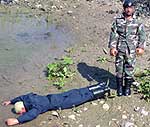
I can't tell if Billy Bonehead is alive and drinking it or if he's dead from drinking it.
|
 |
Because a tree holds an enormous amount of water, if you tie a clear plastic bag over and around a leafy green branch, you'll be able to produce water through condensation. Important: Make sure the bag is tightly sealed over and around the branch or it won't produce any condensation water at all. |
No matter where you go today, plastic and glass bottles can be found littered almost everywhere, even in some of the most remote and isolated places of the world. Really! (Well maybe not everywhere.) And if you take a "green" leafy branch and place it inside a bottle and seal it close, by the end of a hot sunny day it'll produce about 1/3 cup of water or more. And so the more bottles or plastic bags you use, the more water you'll be able to produce. Figure it out bubba, it's in the math. |
 |
 |
And of course, the best time to acquire clean drinking water is when it rains too. And the fastest and easiest way to gather it is by laying out sheets of plastic such as from trash bags. But if you don't have anything to carry the water in, then it's probably best to just roll up the sides of a trash bag and allow mother nature to slowly fill it and then close when it's full or stops raining. |
And lastly, in the early mornings and sometimes late at night. If you tie a couple of handkerchiefs or rags around your ankles or around the end of a stick and walk through some tall grass...you'll be able to soak up quite a bit of moisture. And then all you gotta do is wring it out into something. Yep, a crude and slow method, but it works! |
|
Now let's talk about how to filter & purify water.
When it comes to filtering & purifying water, you can't screw around and take shortcuts. And so you either do it right or you'regonna risk becoming ill or worse.. you could die from improperly treated water. So what's the difference between filtering and purifying water?
Filtering is the removal of all "visual" particles and matter from the water such as dirt, leaves, insects, etc so it can be properly purified and then safely consumed.
Purifying is the removal of all "invisible" bacteria, germs and other harmful elements from the water so it can be safely consumed.
You got it? In other words.. before you can consume untreated water, you've got to purify it, and before you can purify it, you've got to filter it first.
Untreated Water + Filtered + Purified = Safe To Drink.
Got it? Now lets move along and I'll show you how to make some water filter. And believe it or not, my techniques are much more simpler than what other survival sites and books teach ya. And if you don't think so, then feel free to send me a nasty e-mail.
This first one is called a "35mm Film Container Water Filter." And yep, as you can guess by the name, it's made out of a 35mm plastic film container. Which you'll need 2 x plastic water bottle caps and either some "white"disposable coffee filters, cotton or a piece of white cloth. |
 |
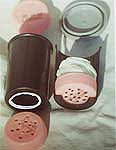 |
Once you have these items, then take a razor blade or a sharp knife and carefully make a circular hole in the bottom of the plastic film container, not too small and not too big. Then take one of the plastic water bottle caps and with either an electric drill, a hot nail or a very pointed knife make a bunch of small holes in it and place it inside the film container. Then take either a disposable coffee filter, some cotton or a piece of white clothe and place it inside the film container and you're now ready to start filtering water. |
Now I'll bet you're wondering, "What's the second bottle cap for?" It's for squeezing out the last few remaining drops of water inside the filter. And also for covering the hole after you have removed the other bottle cap from the bottom of the film container so you can keep it clean when you're not using it.
When should you replace the coffee filters, cotton or white cloth? When either (a) the water is starting to drip very slowly through the filter, (b) no water will run through the filter anymore or (c) no matter how many times you run the dirty water through the filtered it keeps looking discolored and not very clear. Which means it's time to change the filter. |
 |
Did you like this water filter tip? Well here's another one you can make with a plastic water bottle. And two different types, a simple and a fancy water bottle filter. Why would you want to make a fancy water bottle filter instead of a simple one?
Maybe not all of your water will come from a very good source such as a moving creek or stream but instead from a stagnant and smelly ol'pond, puddle or swamp. And not only is it important to properly filter this particular type of water but to rid it of any foul and bad odor & taste . Which is why it's good to know how to make a simple and a fancy water filter.
And to make one, all you need is an empty plastic water bottle and three socks. No socks? Then use three handkerchiefs or pieces of cut up clothe, preferably white. Then all you gotta do is cut the bottle in half, roll up tightly each sock, turn the top half of the bottle upside down and .
| a) |
Place the first sock inside the bottle and on top of it place some "black" pieces of burnt wood charcoal from a fire making sure it contains absolutely "no white ashes" at all. NONE! Or it will further contaminate the water. |
| b) |
Then place the second sock inside the bottle and on top of it place some non-salty sand from stream, creek or river. IMPORTANT: Never use any sand from a beach, it's too salty, you must use only non-salty sand from non-salty water. |
| c) |
And then place the third sock inside the bottle and place either green moss or grass inside of it. The purpose of this filter system is to remove any foul odor or taste from the water. It does NOT purify the water, it just filters and removes bad the odor/taste. |
| Ranger Rick's Water Filter System |
Here's what goes inside these two water filter systems... |
What survival books teach you. |
 |
| * |
1st Sock |
Green Grass/Moss |
1st Hanky |
|
|
|
|
|
|
| * |
2nd Sock |
Non-Salty Sand |
2nd Hanky |
|
|
|
|
|
|
| * |
3rd Sock |
Burnt wood/charcoal |
3rd Hanky |
|
|
|
|
|
|
|
|
 |
 |
As you can see the most important part of this filter system is the socks, they should be rolled up very tight. And when placed inside the plastic water bottle they should fit snug & tight inside.
WARNING: When pouring water through this type of filter system, look closely at the water to make sure it's clear. And if it isn't, then run the water back through it again. If necessary again and again and again until it looks filtered and clear. |
Ok, this was my fancy water filter system for nasty smelling and discolored water. Now here's my simple water filter system for somewhat clear and odorless water. And so all you need for this system is an empty plastic water bottle, a clean "white" sock and then look closely at these photos below to see how easy it is to make. No matter which filter system you decide to make and use, they work better if you can find a"white" sock, cloth, cotton or coffee filter so you can see when it's dirty and needs to be washed out, changed and replaced. Makes sense, don't ya think? |
|
Now there is another way you can filter dirty water, though it's a bit time consuming, it works great. What you'll need is two containers, one to hold the dirty water and the other will be used to catch the clear filtered water. You'll also need a piece of clothe, "cotton" and NOT some sythetic material or this water filter system won't work. Then what you do next is place the two containers side-by-side and make sure the container "holding the dirty water" sits up higher than the empty container. Then take your piece of cotton clothe (ripped from your t-shirt, handkerchief, sock, etc) and place one end in the container holding the dirty water and the other end just barely inside the empty container. Now here's what will happen...
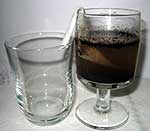 |
 |
 |
| Place a piece of clothe.. |
between 2 containers... |
hours later filtered water. |
As the cotton clothe gets saturated and wet with water it will follow the cotton fibers up one end (from the dirty water container) and then down into the empty container. And as it moves through the clothe the dirt will get filtered out and you'll find nothing but "clear water" in the other container. But for this method to work properly, both ends of the clothe must be "roughly cut" so the water can be able to flow freely through the cotton fibers. Now if you should notice the water has stopped flowing, that means the end of the clothe, the one in the dirty water is cloggged. To unclog just trim the bottom portion of the [dirty] cloth to get the water flowing again. Again, though this method is quite slow and time consuming, the more pieces of clothe you use the faster it works. Makes sense, don't it?
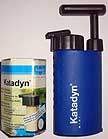 |
Now let's talk about how to "purify water" and boy are there some expensive water filters and purification gadgets on the market today. And the only ones who can really afford to buy them are those who are rich & wealthy. And so if you're one of those who are not so rich or you're a tightwad money saver like me, then you'll probably want to purify your water either by boiling it, bleaching it or by using some water purification tablets instead. |
TO BOIL IT - You'll need a fire and a metal pot or can, and once you have this pour the "filtered water" inside the pot or can, place it over the fire and then sit back and wait until it starts to boil. Sound simple enough to do? It is if you know the difference between "simmering" and "boiling."
 |
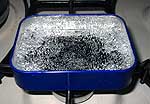 |
 |
This is "cool" water... |
this is "simmering" water... |
and this is "boiling" water. |
Simmering - is when the water releases visual vapors because it's starting to get hot, but there's no sound or bubbles coming from the pot/can.
Boiling - is when the water releases visual vapors and you can hear sounds coming from the pot/can and when you look inside you can see bubbles on the surface of the water.
Now once it starts to boil, to make sure all the germs, bacteria and other invisible harmful suckers are killed you need to let the water boil for a minimum of 7 minutes. Don't worry about over boiling it, it's better to boil it more than 7 minutes than to risk not killing all those harmful micro-organisms and other nasty critters. And then once you've done this all ya gotta do now is sit back and wait until it cools before you can drink it.
TO BLEACH IT - According to the Clorox Bleach manufacturer, it takes four (4) drops of regular Bleach, NOT the scented, lime or other type of bleach for every 1 x quart or liter of clear water before you can safely drink and consume it. But if the water doesn't have a slight bleach odor to it after you have waited 30 minutes, repeat the process again.
IMPORTANT: To confirm this dosage is still current today read what it says on a bottle of "regular" Clorox Bleach or call their consumer hotline to verify the dosage at 1-800-292-2200.
I know what you're think."How in the hell am I suppose carry some of this Clorox bleach with me or in my survival kit? What you'll need are some plastic drinking straws, silicone, a piece of paper and a bottle of Clorox "Regular" Bleach.
WARNING: Use strictly Clorox "Regular" Bleach and never the scented, lime or other type of bleach or it could be harmful or fatal to your health.
 |
Then take a drinking straw, cut it into several 1 inch long pieces, place a few drops of silicone on the cardboard and then place these 1 inch pieces of straws in the silicone and wait about a day for the silicone to dry.
When they're dry, grab another straw and dip one end into the Clorox Bleach and place your finger over the other end to trap the liquid inside. Then very carefully lift it out and over the top of the 1 inch pieces of straws and allow only 5 - 6 drops to drip inside each straw. Then take some silicone and seal these straws close without silicone touching the bleach inside of it.
Why 5 - 6 drops of Clorox Bleach and not 4? When you go to open and use it to purify your water, you're going to lose about a drop or so. So it's better to add an extra drop or two so you won't short yourself of any Clorox Bleach. Makes sense, don't it? |
Once the silicone is dry you can then peel and remove the straws from the paper and place them inside your survival kit until you need to use'em. But if you don't use 'em for a long time, because I don't really know how long the Clorox Bleach will stay good inside these straws. Then I suggest you open one up every 3 - 6 months to see if it still has a strong bleach odor, and if it doesn't and or the liquid looks kinda strange.replace 'em.
| CAN URINE and SALT WATER BE MADE INTO SAFE DRINKING WATER? Every so often someone asks me this quesiton and the answer is "yes." And this here is one way you can do it, (see photo). What you'll need is 2 x cans + 2 x [can] covers + something made out of metal or aluminum to connect the two cans/covers and of course fire. For this method to work you will need (a) to place the urine or salt water in one can which will go into the fire, (b) place another can on some rocks sitting higher up and away from the fire, (c) cover both cans with a lid and (d) connect the two cans with a metal or aluminum tubing. How does it work? As the fire heats the urine or salt water in the first can it will produce sterile water vapors & steam that will rise and flow through the tubing and into the second can which when cooled can be safely consume. The more urine or salt water you boil the more steam & water vapors you'll produce. |
|
WATER PURIFICATION TABLETS - You'll need to buy a bottle of water purification tablets or sometimes referred to as iodine tablets from a military / outdoor supply store. Now the only thing that I don't like about water purification tablets that come in a "bottle," once the bottle is open and the seal is broken you gotta use'em all up within 6-12 months or you gotta throw'em away.
 |
Why? Well once the seal is broken and the tablets come in contact with the air they begin to lose their potency to purify water. Not right away but over a period of time, about a year or so depending on how often you keep opening and closing the bottle and exposing the tablets to the air.
How do you use'em? Well it depends on which type you buy, so the best advice I can give is to tell you to read & follow the instruction on the side of the bottle if you don't wanna get ill.
NOTE: Avoid picking up the tablets with your bare fingers, because due to your natural skin moisture/oils it causes the tablets to change color and quickly deteriorate, use a pair of tweezers to place them inside the straws. |
And sold separately but only when ordered with my SOS Survival Kits...
Army Ranger Rick's "Mini Water Container Kits" - 2 X Types
|
|
1 Person/1 Day Water Container Kit
1 x Condom
4 x Aquatabs |
1-2 Person/Day Water Container Kit
2 x Condom
8 Aquatabs |
NOTE: Aquatabs water purification tablets are manufactured outside the US and manufactured by Medentech Ltd. located in Wexford - Ireland. And as it states on the package: For disinfection of water prior to drinking, washing fruit, vegetables, etc."
DID YOU KNOW . Water purification tablets that come in small bottles are only good for about 12 months or so once the seal is broken and the tablets are exposed to the air? That's right, so you have a choice, you can either use'em all up within a few months, throw'em away or risk becoming ill should they lose their water purification potency.
While there are no known water purifiers that will kill 100% all the germs, bacteria and diseases, except when water is boiled for 7 minutes or more. Aquatabs are not FDA nor EPA approved and therefore should only be used in an emergency only when there is no way to boil water for safe consumption. Provided, of course the water is clear, not foggy, dirty, smelly or discolored.
If you've never heard of using condoms as water containers. Well believe it or not, condoms [the non-lubricant type] have been around and packed inside military survival kits as far back as 1944. Really, No BS! Not for sexual use but as compact improvised water containers. Though the military was the first to use'em in their survival kits, it wasn't long before commercial companies and outdoor enthusiasts started carrying and packing them in their survival kits too.
Now every so often someone sends me an email asking... "Hey Army Ranger Rick, why condoms and not balloons?"
Why? Because condoms are made of "latex" and are a much more stretchable, flexible and durable. Plus they won't puncture or break so easy like "rubber" balloons. To fill a rubber balloon with water, you gotta force it in with a hose or facet and then quickly tie it off so it won't squirt or shoot back out. Not so with condoms because they stretch as you fill'em with water and so you don't have to worry about the water squirting back out even when you drink from them. How do you fill a condom with water?
Believe it or not, I have yet to find a military, outdoor or survival site that explains nor shows you how to fill a condom with water. And so allow me to be the first website to show you how to do it. To fill a condom with water, all ya gotta do is this.
 |
|
|
(a) open & hold with one hand... |
(b) carefully dip it in the water... |
(c) stretch & force the water down... |
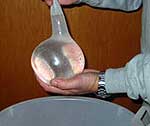 |
|
|
(d) repeat until it's full of water. |
(e) Drop in water tablets, wait & drink. |
Got an extra sock? |
BE CAREFUL: When filling condoms don't ever place them on the ground or allow them to come in contact with tree brances, rocks, pine needles, etc or you could accidentally puncture a hole in them, always handle them with care.
HOW TO USE AQUATABS: As it states on the packaging, "for disinfecting water before drinking, but the water MUST be clear and NOT foggy or dirty. If it is, it needs to be filtered first before proceeding. Then for every 1 x liter or 1 ¾ pints of "clear" water, add 1 x Aquatab purification tablet and then wait 30 minutes or more before consuming. As per further instructions listed on the label... To use for washing fruits & vegetables for safe consumption: add 3 x Aquatabs per each 1 x litre or 1 ¾ pints of water, wait 10 minutes and then use it to wash, rinse, and clean the fruit & vegetables. Contents: Each Aquatab contains 8.5 mg Sodium Dichioroisocyanurate equivalent to 5 mg free available chlorine."
PLEASE READ CAREFULLY: I am selling only the condom & container and NOT the Aquatabs, they come free and are used at your own risk. Though they are produced in conformance with internationally recognized specifications and manufactured to pharmaceutical standards in accordance with EU medical guidelines, they are not [yet] FDA or EPA approved. Failure to follow the Aquatab packaging instructions could be hazardous to your health, so please read carefully before using and check the expiration date too.
NOTE: Upon receipt of my water container kit it is the buyer and user's responsibility to: (a) inspect the Aquatabs to insure they all arrived sealed in the package, (b) read carefully and follow the Aquatab instructions and (c) insure the Aquatab expiration date has not expired. Should you have any questions about ther Aquatabs, contact the Aquatab manufacturer which the address is listed on the pacakge.

Q & A FACTS ABOUT AQUATABS AS PER THE MANUFACTURER
How do AQUATABS® water purification tablets work?
Each AQUATABS® tablet contains a measured dose of Sodium Dichloroisocyanurate, commonly referred to as NaDCC. When added to water AQUATABS® dissolve to release a measured dose of hypochlorous acid (free available chlorine) that is universally recognized as a safe and effective water disinfectant.
Do AQUATABS® water purification tablets colour the water or leave a taste?
No, unlike other water purification treatments such as Iodine or Chlorine Dioxide, AQUATABS® will not colour the water or leave an unpalatable taste. NaDCC works very differently from traditional chlorine, and as such, it is very difficult to taste any chlorine taste. In fact, there is usually less of a chlorine taste in water treated with AQUATABS® than there is in any municipal tap water.
Do AQUATABS® water purification tablets meet any sort of certification?
Yes, the NaDCC used in AQUATABS® is certified to NSF/ANSI Standard 60 and has been approved for drinking water treatment by the U.S EPA (Environmental Protection Agency) and the WHO (World Health Organization)/JECFA. AQUATABS® also conform to WHO Specification (The New Emergency Health Kit (98), International Red Cross and Red Crescent Movement specification (Code: Type 21.1), UNICEF specification (Codes: S 1588350 / S 158355 / S 0003245) and NATO Stock Number (NSN) 6850-99-225-1833).
Are AQUATABS® water purification tablets made to a certain level of quality?
Yes, AQUATABS® are produced in conformance with internationally recognized specifications, and are manufactured to pharmaceutical standards (certified in accordance with EU Guidelines for Good Manufacturing Practice for medicinal products), which is essential for this type of product.AQUATABS® are manufactured by Medentech Ltd. who are accredited to the international quality standard ISO 9001:2000
Are AQUATABS® water purification tablets safe to handle?
Yes, AQUATABS® are safe to handle and unlike other water purification treatments such as Iodine or Chlorine Dioxide, do not require gloves, protective eyewear, or other protective gear to use. In fact, you can safely dissolve an Aquatabs tablet right in the palm of your hand.
Are AQUATABS® water purification tablets a new product?
Yes and No. AQUATABS® have been around for over 20 years in areas such as Europe and Asia but are new to North America markets.
What precautions are recommended when using AQUATABS® water purification tablets?
The following general precautions are recommended when using AQUATABS®: Keep out of reach of children. Do not swallow tablets. If tablets are swallowed, seek medical advice immediately and show outside packaging. Wash after handling. Do not mix with other products. Store in a cool, dry place.
How long does it take for AQUATABS® water purification tablets to dissolve once placed into water?
AQUATABS® take less than one minute to completely dissolve once placed into water and leave no residue or sediment.
How soon can you drink water after treating with AQUATABS® water purification tablets?
In most situations, water treated with AQUATABS® is safe to drink after 30 minutes. In some temperatures and conditions, 60 minutes might be recommended. Please see the dosage chart included with each product for more information.
Can AQUATABS® water purification tablets be used in cloudy or extremely dirty water with high levels of organic matter and turbidity?
The more sediment and/or organic matter within the water to be treated, the more chances that bacteria, viruses and cysts will be able to "hide" from the chlorine disinfectant. As excessive amounts of disinfectant react with the sediment and/or organic matter, there may not be enough disinfectant to inactivate important contaminants such as bacteria and viruses. All water to be treated with AQUATABS® should be clear. Filtering suspect water through a t-shirt or coffee filter is more than sufficient.
Do AQUATABS® water purification tablets contain Iodine?
No, AQUATABS® do not contain Iodine. Iodine of course have been found to cause a number of side affects and health hazards when used as a water purification agent, notably when used by pregnant women and/or when used on a long term basis.
Can AQUATABS® water purification tablets be used on a long term basis?
Yes, AQUATABS® produce extremely safe levels of free available chlorine that
are comparable to those found in municipal tap water.
Do AQUATABS® water purification tablets have an expiration date or shelf life?
Yes, AQUATABS® left in their original foil packaging and stored in a cool, dry place have a shelf life of 5 years. Please refer to the expiry date printed on each strip of 10 tablets (MM/DD/YY).
Can AQUATABS® water purification tablets be used to wash and/or disinfect fruits and vegetables?
Yes. When using AQUATABS® to make water safe before WASHING fruits, vegetables, spinach and other produce, use Aquatabs for 1 or 20 L. When the desire is to DISINFECT fruits, vegetables, spinach and other produce, use the AQUATABS® Food Safe Plus product and directions.
Are AQUATABS® water purification tablets effective against the cysts Giardia and Cryptosporidium?
AQUATABS® are effective against Giardia when used as directed. Usually a double dose is required in very cold water (5C). AQUATABS® are not however effective against Cryptosporidium. For more information on Cryptosporidium please refer to "Water 101". If Cryptosporidium is suspected, boil the water for 7-10 minutes depending on the elevation or filter to a level of 1 micron absolute and then treat with AQUATABS® to inactivate remaining bacteria and viruses that filtration does not generally remove. |

